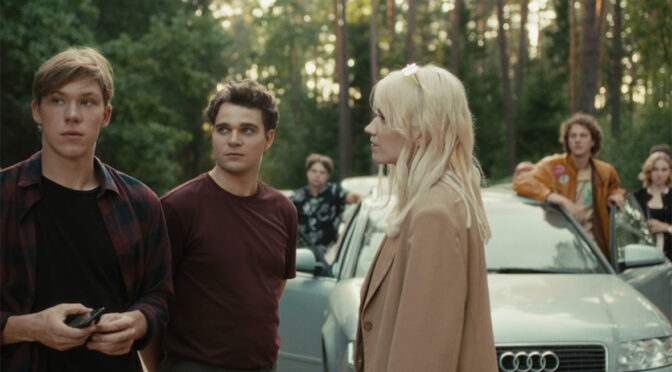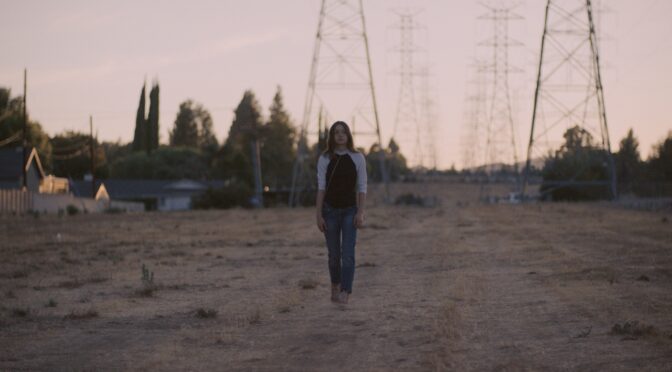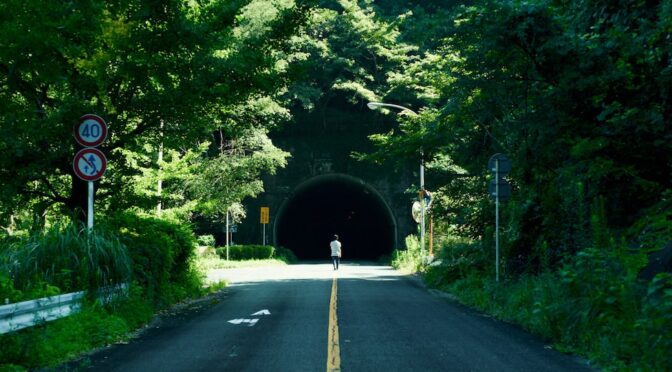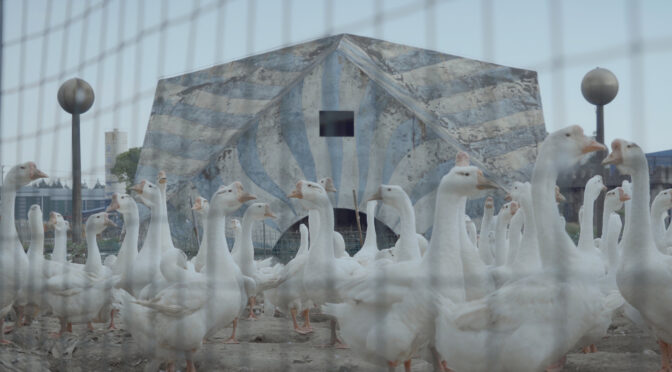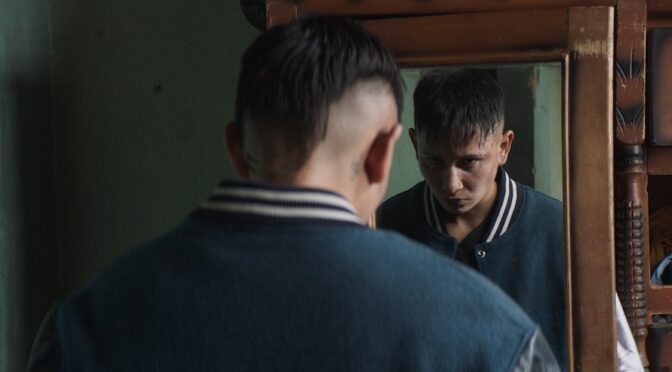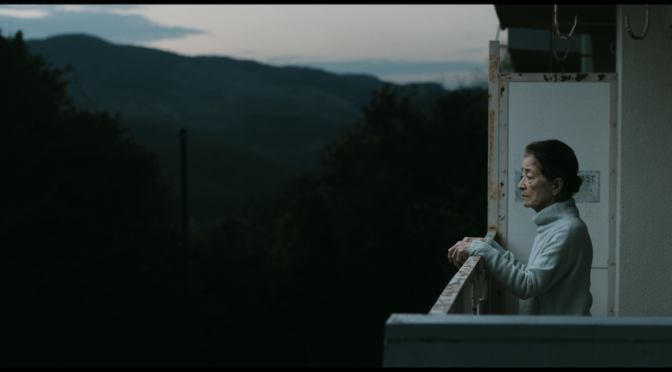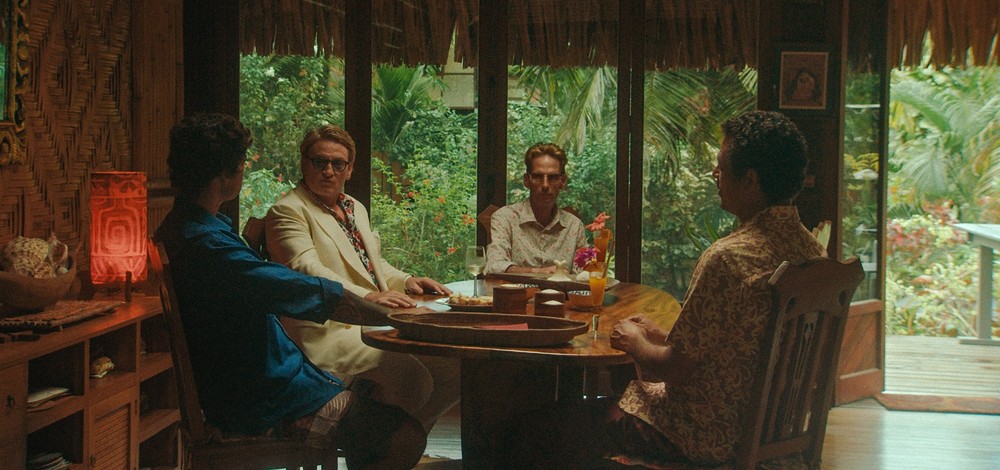Una classe di diplomandi, una festa sfrenata in un cottage sperduto nei boschi della Lituania, un serial killer mascherato. Bastano questi pochi elementi a qualsiasi conoscitore dell’horror per intuire dove ci porterà Jonas Trukanas con la narrazione di Pensive, la sua opera prima in concorso nella sezione “Crazies” del quarantesimo Torino Film Festival.
Continua la lettura di “PENSIVE” DI JONAS TRUKANASArchivi tag: TFF40
MALCOLM MCDOWELL AWARDED IN TURIN
Article by: Davide Troncossi
Translated by: Maria Bellantoni
Honoured by the 40th Turin Film Festival with a retrospective and awarded with the Stella della Mole prize, Malcolm McDowell has been one of the best-known British actors in the world for more than half a century. In particular, for his unforgettable performance as the sadistic and violent Alex De Large in Stanley Kubrick’s A Clockwork Orange (1971).
Leggi tutto: MALCOLM MCDOWELL AWARDED IN TURINIt is difficult to talk about such a popular but atypical figure without repeating what has already been written about him over the decades. McDowell has never been a canonically understood star or even the darling of a specific season or cinematic current. Nevertheless, he has been able to traverse a variety of narratives in European and overseas contexts throughout his prolific career, often guided by great auteurs.
After gaining experience in the theatre, he made his debut in 1968, immediately starring in one of the last peaks of British Free Cinema and a Palme d’Or at Cannes, Lindsay Anderson’s If… (and with this director he would repropose the character of Mick Travis in a sort of truffautian cycle in the following O Lucky Man! in 1973, and Britannia Hospital in 1982). After the unjustly forgotten Figures in a Landscape (1970), an en plein air dystopian film directed by Joseph Losey, Kubrick had no hesitation in calling him out. The ineffable tenderly childlike gaze capable of transforming itself into a perverse grin with the mere hint of a smile was indeed truly unique and terrifying, and embodied the very essence of the very young criminal from the pen of Anthony Burgess.
Having attained his place in the pantheon of the seventh art (not without courageous sacrifices – just remember the serious corneal injuries suffered during the endless filming of the famous ‘Ludovico technique), McDowell’s image was marked for better or worse by those dazzling beginnings, failing to follow up on that first happy season. However, by stubbornly getting back into the game from the 1980s onwards, he was able to start a prolific second professional life, carving out a space in which to express his versatility, often in secondary roles, but always leaving a personal mark beyond the actual merits of the films.
We remember Cat People by Paul Schrader (1982), The Assassin of the Tsar by Karen Shakhnazarov (1991), Gangster No. 1 by Paul McGuigan (2000), Evilenko by David Grieco (2004), a couple of Altman and Mike Kaplan’s tasty one-man show Never Apologize (2007) to remember his friend/mentor Anderson in his own way. We tasted this ability as a performer also during the festival, in a masterclass full of anecdotes and brilliant jokes and, again, in the witty presentations of the films on offer, demonstrating a verve (79 years old and he looks great), the charisma and at the same time the affability of the star capable of involving even the youngest audiences.
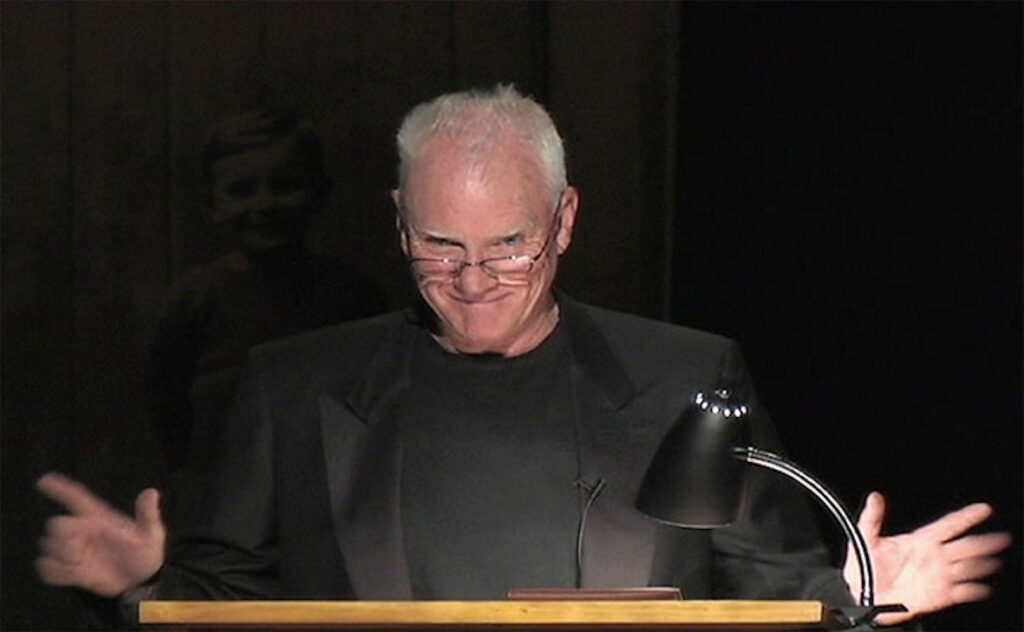
The Turin prize helps fill the gap of the far too few awards given by the film world to McDowell (he was snubbed by the Oscars and the Baftas, he had a single Golden Globe nomination, a special European Film Awards, and a special Nastro d’Argento), but meeting him in person allowed us once and for all to dispel the evil aura that surrounds his cinematic double: Malcolm was never Alex.
MALCOLM MCDOWELL PREMIATO A TORINO
Omaggiato dal 40° Torino Film Festival con una retrospettiva e insignito ieri del premio Stella della Mole, Malcolm McDowell è da oltre mezzo secolo uno degli attori inglesi più noti al mondo, in particolare per l’indimenticabile interpretazione del sadico e violento Alex De Large in Arancia Meccanica di Stanley Kubrick (1971).
Leggi tutto: MALCOLM MCDOWELL PREMIATO A TORINOArduo parlare di una figura così popolare ma atipica senza ripetere quanto già scritto su di lui in questi decenni. McDowell non è mai stato una star canonicamente intesa e nemmeno il beniamino di una specifica stagione o corrente cinematografica, eppure ha saputo attraversare nell’arco della sua prolifica carriera svariate narrazioni in contesti europei e oltreoceano, guidato spesso da grandissimi autori.
Dopo essersi fatto le ossa a teatro, esordisce nel 1968, subito protagonista, in una delle ultime vette del Free Cinema britannico e Palma d’oro a Cannes, Se… di Lindsay Anderson (e con questo regista riproporrà il personaggio di Mick Travis in una sorta di ciclo truffautiano nei successivi O Lucky Man! del 1973, e Britannia Hospital del 1982). Dopo l’ingiustamente dimenticato Caccia sadica (1970) distopia en plein air diretta da Joseph Losey, Kubrick non ha alcuna esitazione nel chiamarlo: l’ineffabile sguardo teneramente infantile capace di trasformarsi con il solo accenno di un sorriso in un ghigno perverso era infatti davvero unico e terrorizzante, e incarnava l’essenza stessa del giovanissimo criminale uscito dalla penna di Anthony Burgess.
Raggiunto il suo posto nel pantheon della settima arte (non senza coraggiosi sacrifici – basti ricordare le serie lesioni corneali subite durante le infinite riprese della celeberrima “cura Ludovico”), l’immagine di McDowell è stata segnata nel bene e nel male da quei folgoranti inizi, non riuscendo a dar seguito a quella prima felice stagione. Rimettendosi però in gioco con caparbietà a partire dagli anni ’80 ha saputo avviare una prolifica seconda vita professionale ritagliandosi uno spazio in cui esprimere la propria versatilità, spesso in ruoli secondari, ma lasciando sempre un’impronta personale aldilà degli effettivi meriti dei film.
Ricordiamo Il bacio della pantera di Paul Schrader (1982), L’assassino dello Zar di Karen Shakhnazarov (1991), Gangster nº 1 di Paul McGuigan (2000), Evilenko di David Grieco (2004), un paio di Altman e il gustoso one man show di Mike Kaplan Never Apologies (2007) per ricordare alla sua maniera l’amico/mentore Anderson. E questa abilità di performer l’abbiamo gustata durante il festival, in una masterclass ricca di aneddoti e battute brillanti e, ancora, nelle argute presentazioni dei film proposti, dimostrando una verve (79 anni portati splendidamente), il carisma e al contempo l’affabilità del divo in grado di coinvolgere anche il pubblico dei più giovani.

Il premio torinese contribuisce a colmare la lacuna dei davvero troppo pochi riconoscimenti assegnati dal mondo del cinema a McDowell (snobbato da Oscar e Bafta, una sola nomination ai Golden Globe, un European Film Awards speciale, un Nastro d’Argento speciale), mentre l’incontrarlo dal vivo ci ha permesso una volta per tutte di scacciare l’aurea malvagia che circonda il suo doppio cinematografico: Malcolm non è mai stato Alex.
Davide Troncossi
“PALM TREES AND POWER LINES” DI JAMIE DACK
“Don’t murder me, ok?”. Con queste parole Lea (Lily McInerny), una giovane ragazza diciassettenne, risponde alla proposta di Tom (Jonathan Tucker), un uomo di trentacinque anni, di accompagnarla a casa in macchina dopo una brutta serata con gli amici. Il tono con cui Lea pronuncia la frase è ironico, ma il suo sguardo perso nel vuoto cela una reticenza di fondo. Forse, in quel breve istante di spensierata interdizione è racchiuso il nucleo di Palm Trees and Power Lines, opera prima di Jamie Dack, già vincitrice del premio alla miglior regia al Sundance Film Festival 2022 e presentata in concorso alla quarantesima edizione del Torino Film Festival.
Leggi tutto: “PALM TREES AND POWER LINES” DI JAMIE DACKIl film presenta uno scorcio della vita di Lea durante le ultime settimane estive prima che ricominci la scuola: la sua quotidianità nella suburbia americana l’annoia, i suoi amici sono infantili e immaturi e il rapporto con la madre Sandra (Gretchen Mol) – unico membro della sua famiglia – è sempre più teso. L’incontro con Tom scuote la ragazza e le offre una via di fuga dalla sua realtà; Lea è affascinata da un uomo più grande ma allo stesso tempo non si lascia completamente andare. Tom si comporta come il fidanzato perfetto: la corteggia, le fa regali e la porta al mare, ma cela un lato oscuro che Lea decide di ignorare e che la porterà a fare i conti con un doloroso trauma nel finale.
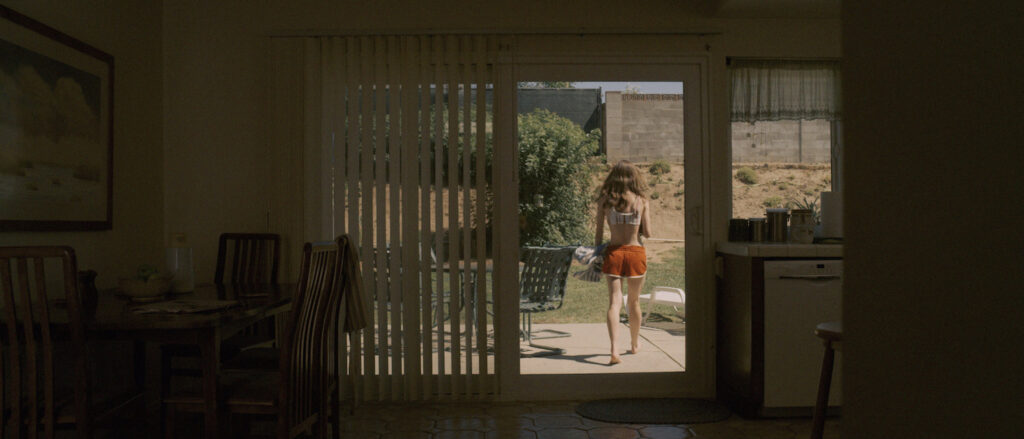
L’intento politico del film è chiaro ma non offusca né la forma né il contenuto. L’opera, infatti, si misura con questioni spigolose come l’adescamento minorile e la difficile realtà di molte famiglie della periferia americana – proprio al personaggio di Lea sono delegate alcune delle battute più gravose come, rivolta alla madre: “Certa gente non dovrebbe avere il diritto di fare figli” – e, allo stesso tempo, offre delle soluzioni formali piuttosto insolite del dramma coming of age. Jamie Dack, infatti, rinuncia a virtuosismi stilistici per offrire una regia sobria e senza sbavature, dimostrando di voler comunicare una necessità, anzi un’urgenza nel narrare determinati eventi piuttosto che soffermarsi sulla componente visiva. Lo sguardo pulito e statico della cinepresa di Dack non solo offre nuove possibilità alla rappresentazione del genere, ma mette in mostra l’originalità del lavoro della regista e il coraggio con cui afferma una personale e autentica visione già a partire dalla sua prima opera.
Luca Giardino
“PALM TREES AND POWER LINES” BY JAMIE DACK
Written by: Luca Giardino
Translated by: Simone Gasparini
“Don’t murder me, okay?” With these words Lea (Lily McInerny), a 17-year-old girl, responds to the proposal of Tom (Jonathan Tucker), a man in his mid-30s, to drive her home after a bad night out with friends. The tone in which Lea utters the sentence is ironic, but her lost gaze conceals an underlying reticence. Perhaps contained in that moment of carefree interdiction is the core of Palm Trees and Power Lines, Jamie Dack’s debut feature, which has already won Best Director at the 2022 Sundance Film Festival and was presented in competition at the 40th Turin Film Festival.
Leggi tutto: “PALM TREES AND POWER LINES” BY JAMIE DACKThe film presents a glimpse of Lea’s life during the last weeks of summer before school starts again: her everyday life in the American suburbia bores her, her friends are childish and immature, and her relationship with her mother Sandra (Gretchen Mol) – the only member of her family – is becoming more tense. Meeting Tom shakes the girl up and offers her an escape from her reality. Lea is fascinated by the fact that Tom is older but at the same time she does not let herself go completely. Tom acts like the perfect boyfriend: he woos her, gives her gifts, and takes her to the beach, but he hides a dark side that Lea decides to ignore and that will lead her to come to terms with a painful trauma in the finale.

The political intent of the film is clear but does not cloud either the form or the content. The work, in fact, deals with such edgy issues as child grooming and the difficult reality of many families in the American suburbs. Furthermore, it also features many burdensome lines, the majority of which are delegated to Lea’s character. To bring an example, she says, referring to her mother, “Some people shouldn’t have the right to have children”. At the same time, the work offers some rather unusual formal solutions of the coming-of-age drama. Jamie Dack, in fact, forgoes stylistic virtuosity to offer understated, unadulterated direction, demonstrating a desire to communicate a need, indeed an urgency in narrating certain events rather than dwelling on the visual component. The clean, static look of Dack’s camera not only offers new possibilities to the representation of the genre, but also showcases the originality of the director’s work and the courage with which she affirms a personal and authentic vision even from her first work.
“CHIUSURA” BY ALESSANDRO ROSSETTO
Article by: Cristian Cerutti
Translated by: Simone Gasparini
Reviewing Chiusura by Alessandro Rossetti twenty-one years after its release makes the analysis of the film even more arduous. Seeing a world that doesn’t exist anymore and sensing the awareness that the world itself had that it had reached a terminal stage – the end of a millennium and all the fears attached to it – generates in the viewer a mixture of anxiety and tenderness. There is love for a fading past but, concurrently, there is the awareness that not much has changed. Even years later, the province remains a swampy, stagnant place that is difficult to escape from but, through the cinematic image, it simultaneously gains a romantic and fascinating appeal. It is precisely the ability to show this double soul of the province and this gap between fading tradition and advancing modernity that makes Alessandro Rossetto’s cinema great. Chiusura, as said by the director himself, is a film that, years later, has become a reflection of the passing of time.
Read all: “CHIUSURA” BY ALESSANDRO ROSSETTOThe documentary, which has been restored by Istituto Luce under Rossetto’s supervision, follows the closure of Mrs. Flavia’s hair salon after 44 years of activity. The director, an anthropology graduate, carefully examines the small gestures of this world, the words of the inhabitants who inhabit it, and the conflicts which animate it. Alongside this world, there are others: the circus which comes to town and the local women’s soccer team. The observation of these worlds focuses in the same way on the imperceptible rituals and conflicts, and on the personal emotions of the people who inhabit them.

However, hovering over this microcosm is the winter fog, a constant element of the film, which amplifies the feeling of stillness and even of finality, namely the closure of a period that has come to its end. Nevertheless, what stands out is the beauty of these elements and real cinema’s ability to give charm to the things of ordinary life. The feeling of paralysis transcends and becomes beauty: personal gestures, words and speeches become captivating and fascinating in the eyes of the viewer.
Elapsed time thus amplifies the experience of viewing Chiusura, to which the reflections on time and the end of an era are added in retrospect to a period that has now passed, but whose emotions and feelings remain incredibly vivid.
“NAGISA” BY KOGAHARA TAKESHI
Article by: Emidio Sciamanna
Translated by: Cora Bruno
Nagisa, a debut feature film by Japanese director Kogahara Takeshi, can be interpreted as a complex and layered attempt to reframe a bond, to redefine that thin filament that connects the body of those who survive and the increasingly evanescent memory of those who are no longer with us. The world that is portrayed is thus the result of a blurred mental condition, a set of indistinct reenactments created by the mind of a boy detached from reality.
Read all: “NAGISA” BY KOGAHARA TAKESHIThe protagonist is Fuminao, a Tokyo boy tormented by guilt over the death of his younger sister Nagisa, who died three years earlier in a bus accident on her way to visit her brother. One night, the boy accompanies his friend Yuki to visit a tunnel that, according to some popular beliefs, appears to be haunted by ghosts. In this mysterious and gloomy place, he will again face his past, his origins, until he relives in his mind the intense relationship with his missing sister. The film is basically a reprise of a homonymous short film by Kogahara himself in 2017, in which the two main characters, again Fuminao and Nagisa, are two young people in love. The adolescent “love story” of the former is thus contrasted, in this second work, with the memory of a deceased person and the reminder of the faint sigh of death, in a mad dance involving Eros and Thanatos until they become part of the same being.
The protagonist’s apathy, as well as the alienation that affects his existence, arise from the strong trauma triggered by the loss of a loved one. For this reason, the young man’s life is constantly punctuated by mechanical movements and continuous silences, depicted through the use of repeated and interminable fixed shots. The story is fragmented, not at all linear, as if every shred of memory spontaneously resurfaces when Fuminao savors certain physical or emotional sensations. This makes the film a real labyrinth with no way out, a puzzle in which, at times, it is difficult to understand the meaning of certain events.

At the end of this enigmatic existential journey, there are many questions that arise, raising more doubts than answers in the protagonist’s mind. “Do ghosts really exist?” the boy hesitantly asks a policeman he meets by chance outside the tunnel. The man’s answer will come only after a long and ostentatious silence: “The ghost is you.” It is those who have remained anchored in the past, unable to continue a normal life, like a woman wandering the streets in search of her missing son, who represent the real ghosts of society.
“PARKLAND OF DECAY AND FANTASY” DI CHENLIANG ZHU
In un saggio sul legame tra reenactment e fantasmatico, Bill Nichols riflette su come tale tecnica sottolinei lo scarto tra presente e passato, ma anche tra percezione soggettiva e oggettiva degli eventi. In questo modo, il reenactment crea una dimensione fantasmatica che annulla l’idea di oggettività totale e ne evidenzia la sua impossibilità. In Parkland of Decay and Fantasy, presentato all’interno del concorso Documentari Internazionali del TFF40, è l’immagine digitale a svolgere la funzione descritta da Nichols: le nuove tecnologie e in particolar modo la loro possibilità di intervento sull’immagine – come nel caso del finale visionario – rendono possibile l’evocazione visiva dei fantasmi al centro della narrazione di Parkland of Desire and Fantasy[1].
Continua la lettura di “PARKLAND OF DECAY AND FANTASY” DI CHENLIANG ZHU“UN VARÓN” DI FABIAN HERNÁNDEZ
Carlos riattacca il telefono e si appoggia al muro. Ha gli occhi lucidi e vorrebbe sfogarsi ma non lo fa perché, come dice lui, “gli uomini non piangono”. Questo è il conflitto che Un varón, il nuovo film di Fabian Hernández, si propone di indagare: quello di un ragazzo che tenta di conformarsi all’ideale di mascolinità che vige nelle strade di Bogotá mentre nel privato vorrebbe solo essere se stesso. Il Natale si avvicina e il suo unico desiderio è quello di passarlo con la sorella, sempre più sfuggente, e con la madre che è in carcere. Uscito dal centro giovanile che l’ha accolto, si ritrova a fare i conti con la vita di strada e la legge del maschio alpha.
Continua la lettura di “UN VARÓN” DI FABIAN HERNÁNDEZ“PLAN 75” DI CHIE HAYAKAWA
Michi (Chieko Baishô) rievoca al telefono i ricordi del proprio passato: racconta la propria vita con malinconia, grata di avere qualcuno che la ascolti. Nella sua cucina non si sente altro se non la sua stessa voce. Dall’altro capo del telefono Yoko (Yumi Kawai) – molto più giovane di lei – è in silenzio. Vorrebbe concentrarsi sul racconto dell’anziana signora, ma la sua testa è altrove. A interrompere il flusso di parole di Michi è un allarme: il tempo a sua disposizione è scaduto. Yoko, trattenendo le lacrime, inizia a illustrarle cosa succederà il giorno seguente e le ripete, quasi come se fosse una supplica, che non è obbligata a farlo. Michi risponde, con tono sommesso: «Sayonara».
Continua la lettura di “PLAN 75” DI CHIE HAYAKAWA“SHE SAID” BY MARIA SCHRADER
Written by: Yulia Neproshina
Translated by: Rebecca Arturo
The unbearable weight of manipulative ambiguity, unfounded guilt, and complicit silences. Maria Schrader’s new film, out of the competition at the 40th edition of the Torino Film Festival, is a protest against Harvey Weinstein that unleashes the desire to cry out that women have been deprived of for so long, and thereby redeems the right to their voice.
Leggi tutto: “SHE SAID” BY MARIA SCHRADERA young woman at the very start of her career, her soul bursting with dreams and her eyes full of naive hope, is overcome by a request as unexpected as it is inappropriate just when she was planning to attend a business meeting. “He ripped out my voice that day, just as I was starting to find it,” discloses Laura Madden, confessing her years-long belief that she was the only one who did not have the strength to stand up to the harassment from the powerful and feared Miramax producer. Laura was far from alone, but her persecutor was for a long time protected by a well-established system that systematically and scrupulously shielded the offenders. New York Times’ reporters Megan Twohey (Carey Mulligan) and Jodi Kantor (Zoe Zakan) undertook an investigative enquiry to expose the harassment and sexual abuse committed by Weinstein, who had crossed not only professional boundaries, but also national borders, committing countless abuses overseas.

The She Said crew is well aware that they are telling a true story and do not allow room for unnecessary violence, to which women are already abundantly exposed.
Weinstein’s towering physical presence is rendered by the oral testimonies of women who describe episodes in which he holds the unmistakable authority of the perpetrator. At the same time, his voice is emblematic, as we hear it in voice over, as violent and arrogant as the suffocating agreements he induced his victims to sign, ‘legally’ depriving them of their dignity. We retrace, guided by these testimonies, the spaces from which they would have so much wanted to escape, as in a nightmare from which they were not allowed to awaken. This film, however, also wants to be a safe space for all the women involved in order to express themselves and share their grief and anger. First and foremost, Megan and Jodi, that we follow far beyond the investigative processes and that Maria Schrader reveals to us with great sensitivity and respect. The cooperation and supervision of those directly involved and their permission to enter into each other’s private lives were undoubtedly essential to achieve the goal of producing a film that resonates strongly and encourages women to trust each other.
“ORLANDO” BY DANIELE VICARI
Translated by: Bendetta Francesca De Rossi
Article by: Francesco Ghio
Having a proper compass on which one can rely can often prove to be a necessity in order not to lose one’s way too much; especially in a society which changes its skin year after year. Sometimes the right compass can be found close by, in one’s own backyard, in the apparent simplicity of a sentence spent by a person close to one’s heart; at other times, it is necessary to move away, especially if one’s loved ones, or at least those who once were, have emigrated, crossing borders, hoping for a better future. Daniele Vicari’s Compass for over ten years was Ettore Scola and Orlando, presented out of competition at the 40th Turin Film Festival, is dedicated to him.
READ MORE“ORLANDO” DI DANIELE VICARI
Avere una bussola adeguata sulla quale si possa fare affidamento, spesso, può rivelarsi una necessità per non perdere troppo la strada; soprattutto in una società che muta la propria pelle di anno in anno. A volte la giusta bussola la si può trovare accanto a sé, nel proprio giardino di casa, nell’apparente semplicità di una frase spesa da una persona vicina; altre volte occorre invece allontanarsi, soprattutto se i propri cari, o almeno quelli che un tempo lo sono stati, sono emigrati, superando i confini, sperando in un futuro migliore. La bussola di Daniele Vicari per oltre dieci anni è stato Ettore Scola e Orlando, presentato fuori concorso alla quarantesima edizione del Torino Film Festival, è dedicato a lui.
Continua la lettura di “ORLANDO” DI DANIELE VICARI“MAN AND DOG” BY STEFAN COSTANTINESCU
Written by: Alessandro Pomati
Translated by: Lia Colombo
Two people are wandering in the depths of the wood; a bus drives into a tunnel whose exit cannot be seen; a thick blanket of smoke. These are just a few of the images that Stefan Costantinescu’s first feature film exploits. On one hand, the viewer can perceive the disorientation that Doru (Bogdan Dumitrache), a laborer who has emigrated to Sweden from Romania, feels upon his return. On the other, we witness his wife Nicoleta (Ofelia Popii), his teenage daughter, and his arteriosclerotic mother’s way of “welcoming” him “back” with no more than surprise and coldness; the only one to feel any genuine emotion seems to be his faithful dog Amza. Behind Doru’s unexpected return there is actually more to than the work-related reason he keeps peddling to anyone who asks: while in Sweden, Doru received anonymous messages informing him of his wife’s alleged marital infidelity. Therefore, the true purpose of his return to Romania is to verify their authenticity.
Read more: “MAN AND DOG” BY STEFAN COSTANTINESCULike many of his compatriots (Cristian Mungiu, Cristi Puiu), Costantinescu is able to create glacial and frozen atmospheres, where tensions swirl without erupting, if not at their very limit. This justifies the cold and aseptic tones of the cinematography, and the indoor shots with the clear aim of “imprisoning” the protagonists. Moreover, those scenes are built with sequence-plans in order to allow the viewer to pick every single word of what the characters say to each other. The risk of epigonism is avoided because the camera, like Doru, also breaks free from staticity and begins to peddle the characters generating a great deal of suspense, in full Hitchcockian style. While witnessing this “stalking” process, we end up putting together the pieces of the image of a country where patriarchal culture still takes hold, where the woman is not even allowed to go have a coffee without her husband’s approval, while the latter’s affairs and escapades are all but forbidden.
Through a withdrawn performance, Dumitrache is remarkably effective in capturing the grotesque dimension of the broken man. Sometimes he also manages to evoke laughter in the viewer – even in the context of domestic violence in which the film is set. Nevertheless, his partner Popii also shines with a great performance of glacial irony. However, any intended or unintended trace of humor disappears in the powerful finale: it dodges the mere consolation aim and seems to suggest that even in a society where everyone is cold, violent, distant (with or without COVID-19), mean, and obsessed with IKEA, one can always find something to hold on to. It is a struggle, but it can be done; even if you are a little bit of a man, and a little bit of a beast.
“MAN AND DOG” DI STEFAN COSTANTINESCU
Due persone che vagano nel folto di un bosco, un pullman che entra in un tunnel di cui non si riesce a vedere l’uscita, una fitta coltre di fumo: sono soltanto alcune delle immagini che Stefan Costantinescu, al suo primo lungometraggio, utilizza per descrivere la sensazione di spaesamento che Doru (Bogdan Dumitrache), operaio emigrato in Svezia dalla Romania, prova al momento del suo ritorno. Il suo arrivo suscita sorpresa, ma anche una certa freddezza nella moglie Nicoleta (Ofelia Popii), nella figlia adolescente e nella madre arteriosclerotica; l’unico a provare un minimo di genuina commozione sembra essere il suo fedele cane Amza. Dietro l’inatteso ritorno di Doru c’è in realtà di più della semplice ragione lavorativa che egli continua a propinare a chiunque glielo chieda: mentre si trovava in Svezia, infatti, Doru ha ricevuto dei messaggi anonimi che lo informavano della presunta infedeltà coniugale di sua moglie. Lo scopo del suo ritorno in Romania è appurarne la veridicità.
Leggi tutto: “MAN AND DOG” DI STEFAN COSTANTINESCUCome molti suoi connazionali (Cristian Mungiu, Cristi Puiu), Costantinescu dà prova di riuscire a creare atmosfere glaciali e sospese, dove le tensioni serpeggiano senza scoppiare se non al limite estremo. Questo giustifica la fotografia dai toni freddi e asettici, le riprese realizzate per lo più in interni con lo scopo di “imprigionare” i protagonisti e, in questi interni, i piani-sequenza volti a non perdere neanche una parola di quello che essi si dicono. Il rischio di epigonismo viene evitato nel momento in cui anche la macchina da presa, al pari di Doru, si libera dalla staticità e comincia a pedinare i personaggi in scene di altissima suspense, in perfetto stile hitchcockiano. A emergere da questo “pedinamento” è l’immagine di un Paese in cui la cultura patriarcale la fa ancora da padrone, dove alla donna non è concesso di prendere neanche un caffè senza l’approvazione del marito, mentre a quest’ultimo le scappatelle e le sregolatezze sono tutt’altro che proibite.
Dumitrache, attraverso uno stile recitativo spesso in sottrazione, è straordinariamente efficace nel catturare la dimensione grottesca del maschio in crisi, riuscendo spesso a suscitare il riso nello spettatore – pur nel contesto di violenza domestica in cui il film si ambienta. D’altro canto, la sua partner, Popii, brilla in un’interpretazione di glaciale ironia. Ma ogni traccia di umorismo, voluto o involontario, sparisce nel potente finale, che sembra suggerire (schivando il proiettile della consolazione) che persino in una società così fredda, violenta, distante (con o senza COVID-19 a tenerci separati), meschina, con l’ossessione di vivere in “stile IKEA”, si può trovare qualcosa a cui aggrapparsi. È una fatica, ma si può fare; anche se si è un po’ uomini, e un po’ bestie.
Alessandro Pomati
“NAGISA” DI KOGAHARA TAKESHI
Nagisa, lungometraggio d’esordio del regista giapponese Kogahara Takeshi, può essere interpretato come un complesso e stratificato tentativo di rielaborare un legame, di ridefinire quel sottile filamento che collega il corpo di chi sopravvive e il ricordo, sempre più evanescente, di chi non c’è più. Il mondo che viene rappresentato è dunque frutto di un’offuscata condizione mentale, un insieme di indistinte rievocazioni partorite dalla mente di un ragazzo distaccato dalla realtà.
Leggi tutto: “NAGISA” DI KOGAHARA TAKESHIIl protagonista è Fuminao, un ragazzo di Tokyo tormentato dal senso di colpa per la morte della sorella minore Nagisa, deceduta tre anni prima in un incidente stradale mentre andava a trovare il fratello in autobus. Una notte il ragazzo accompagna l’amico Yuki a visitare un tunnel che, secondo alcune credenze popolari, pare essere infestato dai fantasmi. In questo misterioso e tetro luogo si troverà ad affrontare nuovamente il suo passato, le sue origini, fino a rivivere nella propria mente l’intenso rapporto con la sorella scomparsa. Il film è in fondo la riproposizione di un cortometraggio omonimo realizzato dallo stesso Kogahara nel 2017, in cui i due protagonisti, sempre Fuminao e Nagisa, sono però due giovani innamorati. Alla “love story” adolescenziale del primo si contrappone quindi, in questa seconda opera, il ricordo di un defunto e il richiamo al flebile sospiro della morte, in una folle danza che coinvolge Eros e Thanatos fino a renderli parte di uno stesso essere.
L’apatia del protagonista, così come l’alienazione che ne condiziona l’esistenza, nascono dal forte trauma scaturito dalla perdita di una persona amata. Per questo motivo la vita del giovane è costantemente scandita da movimenti meccanici e continui silenzi, raffigurati attraverso l’utilizzo di reiterate e interminabili inquadrature fisse. La storia è frammentata, per nulla lineare, come se ogni brandello di memoria riaffiorasse spontaneamente quando Fuminao assapora determinate sensazioni fisiche o emotive. Questo rende il film un vero e proprio labirinto senza vie d’uscita, un rompicapo in cui, talvolta, risulta difficile comprendere il senso di alcuni avvenimenti.

Al termine di questo enigmatico viaggio esistenziale sono molte le domande che sorgono, suscitando nella mente del protagonista più dubbi che risposte. «I fantasmi esistono davvero?» chiede esitante il ragazzo a un poliziotto incontrato casualmente fuori dal tunnel. La risposta dell’uomo arriverà solo dopo un lungo e ostentato silenzio: «Il fantasma sei tu». Sono coloro che sono rimasti ancorati al passato, incapaci di proseguire una vita normale, come una donna che vaga per strada alla ricerca del figlio scomparso, a rappresentare i veri spettri della società.
Emidio Sciamanna
“WAR PONY” DI RILEY KEOUGH E GINA GAMMELL
Presentato in concorso alla quarantesima edizione del Torino Film Festival, già vincitore della Camera d’Or a Cannes, dove concorreva nella sezione Un Certain Regard, War Pony segna l’esordio alla regia dell’attrice Riley Keough e della produttrice Gina Gammell, con un appassionante ritratto della comunità di nativi americani coinvolta direttamente nella realizzazione del film.
Continua la lettura di “WAR PONY” DI RILEY KEOUGH E GINA GAMMELL“UNREST” BY CYRIL SCHÄUBLIN
Article by: Sara Longo
Translated by: Rachele Pollastrini
“After spending a few weeks with the watchmakers, my views on socialism were resolved: I was an anarchist.” With this sentence by Pyotr Kropotkin extracted from his Memoirs of a Revolutionary (1877), director Cyril Schäublin decided to start his second feature film ‘Unrest’ in which, by reconstructing the events of 1870, he recounts how the independence of thought of the artisans in the Jura Mountains ignited the spark for the birth of the international anarchist movement.
Continua la lettura di “UNREST” BY CYRIL SCHÄUBLIN“PACIFICTION” BY ALBERT SERRA
Article by: Irma Benedetto
Translated by: Alice Bettinelli
When approaching the work of Albert Serra, we cannot help but notice the great contradiction at the heart of his cinema: that between the setting of his images, which nestle in the past of the European history (from the 1980s of his debut film to the 1700s French – his favourite historical period – of La mort de Louis XIV and Liberté) and the sense of atrophy, of an absolute and out-of-time present that apocalyptically pervades his characters, always waiting for a climax that will never come, or that perhaps has already arrived.
Read more: “PACIFICTION” BY ALBERT SERRAA spasmodic wait for the end that becomes nuclear paranoia for a Benoît Magimel called to play the ambiguous protagonist of Pacifiction, a diplomatic commissioner who has arrived in the former French colony of Tahiti to try to investigate unsettling rumours of an imminent resumption of dangerous atomic tests. Serra works on the extreme stylisation and opacity of the characters and on the exhibited artificiality of lights – as was already the case in the unforgettable finale of Liberté – to create a highly suggestive visual texture, a floating and uncertain space in which it is possible to perceive the abstraction of power in all its ruthless and pervasive senselessness. It is between half-voices and hints that the protagonist De Roller – designated intermediary between the politicians and the population – probes the island moving as if in a limbo – a somnambulist wandering in what seems to be an only-apparent state of life. The viewer is restrained in the hypnotic movement of the film, which concedes few clues and casts wide, unresolved grey areas, constantly moving to an unknowable off-screen that weights like an omen.
To duplicate and amplify the feeling of threat that travels under the skin, there is the eerie presence of the ocean, which with its surface engulfs and conceals. De Roller is driven by a desire for clarity that will never become tangible reality. In the most important dialogue-monologue of the film, the protagonist talks about a world that has lost the conception of time and memory, of a humanity that must have as its primary need that to illuminate, to see the withered skins of power that have already been embodied by the exposed and dying body of Jean-Pierre Léaud in La mort de Louis XIV. With Pacifiction, Serra continues his work on the perception of the present and the invisible decomposition of a frozen and motionless time, aiming his gaze for the first time at contemporaneity.
“PACIFICTION” DI ALBERT SERRA
Quando ci si accosta all’opera di Albert Serra non si può fare a meno di notare la grande contraddizione che sta alla base del suo cinema: quella fra l’ambientazione delle sue immagini, che si annidano nel passato della storia europea (dagli anni ’80 del film d’esordio al 1700 francese – periodo storico da lui prediletto – di La mort de Louis XIV e di Liberté) e il senso di atrofizzazione, di presente assoluto e fuori dal tempo che pervade in maniera apocalittica i suoi personaggi, sempre in attesa di un climax che non arriverà mai, o che forse è già arrivato.
Leggi tutto: “PACIFICTION” DI ALBERT SERRAUn’attesa spasmodica della fine che diventa paranoia nucleare per un Benoît Magimel chiamato a interpretare l’ambiguo protagonista di Pacifiction, un commissario diplomatico arrivato nell’ex colonia francese di Tahiti per cercare di indagare su inquietanti voci che vogliono un’imminente ripresa di pericolosi test atomici. Serra lavora sull’estrema stilizzazione e opacità dei personaggi e sull’artificialità esibita delle luci (come già avveniva nell’indimenticabile finale di Liberté) per creare una tramatura visiva di grande suggestione, uno spazio flottante e incerto in cui si riesce a percepire l’astrazione del potere in tutta la sua spietata e pervasiva insensatezza. È fra mezze voci e accenni che il protagonista De Roller, tramite designato fra i politici e la popolazione, sonda l’isola muovendosi come in un limbo: un sonnambulo che vaga in quello che sembra uno stato di vita solo apparente. Lo spettatore viene imbrigliato nel movimento ipnotico del film, che concede pochi indizi e lancia ampie zone d’ombra irrisolte, rimandando costantemente ad un fuori campo inconoscibile che grava come un presagio.
A duplicare ed amplificare la sensazione di minaccia che viaggia sottopelle è la presenza inquietante dell’oceano, che con la sua superficie inghiotte e nasconde alla vista. De Roller è guidato da una volontà di chiarezza che non si concretizzerà mai: nel dialogo-monologo più importante del film il protagonista parla di un mondo che ha perso la concezione del tempo e della memoria, di un’umanità che deve avere come necessità primaria quella di illuminare, di vedere le pelli avvizzite del potere che sono già state incarnate dal corpo esposto e morente di Jean-Pierre Léaud in La mort de Louis XIV. Serra continua con Pacifiction il suo lavoro sulla percezione del presente e sulla decomposizione invisibile di un tempo raggelato e immobile, puntando il suo sguardo per la prima volta sulla contemporaneità.
Irma Benedetto

